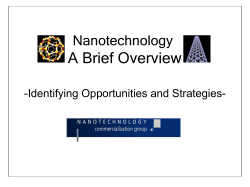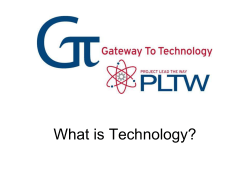
Nanotechnology for Energy and Environment BIOE298 DP
Nanotechnology for Energy and Environment BIOE298 DP Sustainable Energy: Need a Major Breakthrough A major technological challenge for human race in 21st century is the transition from fossil-fuel-based energy economy to renewable (sustainable) energy one. • Collective energy demand of the planet is predicted to be doubled by the mid of 21st century and to be tripled by the end of this century. • There is a urgent need to develop CO2- neutral energy sources. • The sustainable energy alternatives should be cost effective. The Importance of Nanoscale Properties Quantum size effects (atomic level of matter) result in unique mechanical, electronic, photonic, and magnetic properties of nanoscale materials • Chemical reactivity of nanoscale materials greatly different from more macroscopic form, e.g., gold • Vastly increased surface area per unit mass, e.g., upwards of 1000 m2 per gram • New chemical formation , e.g., fullerenes, nanotubes of carbon, titanium oxide, zinc oxide, other layered compounds • The melting point of gold particles decreases dramatically as the particle size gets below 5 nm • For nanoparticles embedded in a matrix, melting point may be lower or higher, depending on the strength of the interaction between the particle and matrix. Benefits already observed from the design of nanotechnology based products for renewable energy are: •An increased efficiency of lighting and heating •Increased electrical storage capacity. •A decrease in the amount of pollution from the use of energy Opportunities of Nanoparticles for Energy and Environment Workshop on Nanotechnologies for Thermal and Solar Energy Conversion and Storage, August 10,11, 2008, Jacksonville, FL Portfolio of solar/thermal/electrochemical energy conversion, storage, and conservation technologies, and their interactions More efficient devices for… • LED-based lighting • Thermoelectric refrigeration • Thermoelectric and thermo-photovoltaic conversion of waste heat • Photovoltaic conversion of solar energy and production of hydrogen Other benefits • Compact • Robust • Low environmental impact Challenges • Efficiency breakthroughs needed! • Availability and price of raw materials • Manufacturing costs Electricity generation accounts for about 37% of primary energy consumption in the U.S. • Lighting accounts for 22% of the nation’s electric power usage. • The DoE SSL Goal: a solid-state lamp that is more efficient, longer lasting and cost competitive compared to conventional technologies, targeting a system efficiency of 50% and the color quality of sunlight. • Implications of Success: 33% reduction in energy consumed for lighting by 2025, eliminating need for 41 1000MW power plants, and saving consumers $128 B+. III-V LEDs cover the visible spectrum, but not with one materials system Compound Semiconductor, June 2008, pg. 17 Low cost solution: Blue (In,Ga)N LED with partially absorbing yellow phosphor Limitations: poor color rendering, low efficiency due to Stokes shift Warm light solution: Board-level integration of (In,Ga)N/yellow phosphor and (Al,Ga,In)P red LEDs Limitations: “green gap”, high cost of assembly Photovoltaic Solar Cells • Generate electricity directly from sunlight • 2 Main types: – Single-crystal silicon (traditional) • Widespread • Expensive to manufacture Silicon-based – Dye-sensitized (“nano”) solar cell • Newer, less proven • Inexpensive to manufacture • Flexible Dye-sensitized solar cell • Problem: Fast energy loss by hot carriers – Hot carriers are produced when solar photons with energy significantly higher than the band gap of the semiconductor is absorbed. Excess energy leads to lattice vibrations and thus affects the efficiency. • Solution 1: Use of Si nanocrystals with different band gap values to capture the full solar spectrum • Solution 2: Use of quantum confined nanocrystals to generate multi-exciton generation Organic dye sensitized solar cells • Charge-carrier recombination problem can be addressed by using nanoparticle /nanostructures. • Carrier collection efficiency can be improved by using one dimensional nanostructures such as nanowires and nanotubes. • Nanotechnology may provide routes for cost reduction by using thin films. Hydrogen from solar water splitting • Photoreduction of CO2 with water to form hydrocarbon (methane, methanol etc.) – This approach is very interesting as using CO2 as a raw material to produce hydrocarbon fuels just by using sun light. – Negative CO2 foot print – Not only interesting from the environment point of view, but also from the view of sustainable transportation using the existing Infra structure for fuel distribution Solar Photocatalysis • TiO2 nanoparticles are used in solar water splitting • Increasing the efficiency of the process is a main challenge • Oxynitride of TiO2 (TiO2-xNx) is a better alternative • Nanosized TiO2-xNx can absorb in the visible region Fuel Cells • Despite the huge advantages, their commercialization is hampered by: – High cost – Durability issues – Operability issues • Solutions for some these bottlenecks will be from nanotechnology • e.g.: Replacing Pt catalysts with some cheaper material in low temperature fuel cells What is the problem? Hydrogen fuel cell development has some practical issues associated with cost benefit and infrastructure development for safety and economics (e.g., fuel manufacturing, transportation, and storage). Although hydrogen has a high energy density by weight, it has a low energy density by volume as compared to hydrocarbon-based fuel cells. Thus, hydrogen storage is one of the bottlenecks for hydrogen fuel cell development since high-pressure compressed gas tanks are large and heavy. In addition, compressing hydrogen to high pressures require energy as well, defeating some of the cost benefits with fuel cells. Liquid hydrogen storage, which does not have a great energy density by volume as compared to hydrocarbon, also requires cryogenic storage – a bulky and expensive option. Hydrogen storage in tanks presently used in hydrogen-powered vehicles a) Hydrogen production and storage by renewable resource, (b) hydrogen storage in metal doped carbon nanotubes , (c) storage in mesoporous zeolite: by controlling the ratio of different alkali metal ions (yellow and green balls), it is possible to tailor the pressure and temperature at which hydrogen is released from the material, (d) hydrogen storage in metal–organic framework (MOF)-74 resembles a series of tightly packed straws comprised mostly of carbon atoms (white balls) with columns of zinc ions (blue balls) running down the walls. Heavy hydrogen molecules (green balls) adsorbed in MOF-74 pack into the tubes more densely than they would in solid form. Hydrgen gas (red) adsorbed in an array of carbon nanotubes (grey). The hydrogen inside the nanotubes and in the interstitial channels is at a much higher density than that of the bulk gas The growth of large-area graphane-like film by RF plasma beam deposition in high vacuum conditions. Reactive neutral beams of methyl radicals and atomic hydrogen effused from the discharged zone and impinged on the Cu/Ti-coated SiO2/Si samples placed remotely. A substrate heating temperature of 650 °C was applied http://www.intechopen.com/books/hydrogen-storage/hydrogen-storage-for-energy-application a) STM images of graphane. The bright protrusions in the image are identified as atomic hydrogen clusters; (b) after annealing at 300 °C for 20 min; (c) after annealing at 400 °C for 20 min; (d) graphene recovered from graphene after annealing to 600 °C for 20 min. Scale bar 3 nm Nanotech Materials for Truly Sustainable Construction 60% of global industrial waste is from the construction and demolition of buildings 60% of electrical use in developed nations is by buildings 40% of total energy consumed is by buildings Old or new? (Damascus 900-1750AD) • Arms race? The first crusaders encountered better steel Wootz steel, developed in India & Sri Lanka ~300 BC greater strength & flexibility due to carbon nanotubes technique lost ~1750AD The Revolution in building science A quick overview Put on your running shoes… Steel Filtration Concrete Electronics / Sensors Glass Tools Gypsum Drywall Coatings & Paints Fabrics & Carpet Lighting Energy/HVAC Insulation Steel Nanocomposite steel is available & stronger (per ASTM) Withstands temperatures as low as -140F Increased plasticity Free of corrosion-causing carbide paths Results: reduced amount of steel Simplified placement of structural concrete 20 to 40% savings Concrete Production of concrete accounts for 8% of total CO2 emissions worldwide Translucent concrete? Glass Can block UV & glare Self-cleaning glass coated (titanium dioxide coating breaks down organic matter Switchable Glass Switch!! Gypsum Drywall Nano-drywall is lighter, stronger and water resistant Fabrics and Carpet Nano-treatments are used on commercial fabrics Color-fast, stain proof and dirt proof Naturally hydrophobic, no mold or mildew Energy / HVAC Solar cells infused with nano-technology are thin, flexible and come in rolls so they can be applied as roofing material Tools Doped Nanophostate Lithium Ion batteries Cordless tools are more powerful than corded! Coatings and Paints Nano particles enhance physical and aesthetic qualities Hard, durable finish Excellent water resistance Scrub-ability Stain blocking and other properties Lighting • LEDs (point source) & OLEDs (sheet) 40% of commercial energy goes to lighting LED is most efficient, sustainable solution 10X more efficient than incandescent 50,000 - 100,000 hours (vs 10,000) "No other lighting technology offers so much potential to save energy and enhance the quality of buildings" U.S. Dept. of Energy Solid-state lighting Big technology push 46% average annual growth from 2001-2004 HB LED market $4.2 billion in 2006 Growing to $9.9 billion in 2011 *Examples: Osram, Philips, OptiLED Holdings (Hong Kong) Solid-state lighting Insulation Aerogel, a translucent thermalacoustic insulator Looks like frozen smoke Best insulating solid in the world Weighs only 90 grams per liter Extremely flexible - blankets, beads, sheets The new “plastic”* *Not really—it’s amorphous silica (sand) How to use these innovations? • Steel • Filtration • Concrete • Electronics / Sensors • Glass • Tools • Gypsum Drywall • Coatings & Paints • Fabrics & Carpet • Lighting • Energy/HVAC • Insulation Sound Transmission: Acoustic Performance •Truck Noise •10 db attenuation 40 - 400 HZ sound transmission •loss 2-3/4” FRP Fiberglass insulation Nanogel® Sound pressure level vs. time About aerogels Well-known, insulating nano-substance that is translucent and 97% air NanogelTM* panels – developed for skylights – Lightweight Hydrophobic Highly translucent Thin Superb thermal / acoustic insulator Manufactured as large, rigid panels Heat, Light, & Noise Thermal Performance R-20 The insulating value of a 6” stud wall Testing Permanence of performance Non-combustible/ no smoke Mold/mildew resistance Condensation resistance UV Stable Noise 50% Sound Reduction More about Aerogels Nanomaterial known since 1931 Used extensively in aerospace NanogelTM is a proprietary form of “aerogel” - skylights - exterior glazing - pipeline insulation - apparel - medical devices More about Aerogels Nanogel used across North America & nine European countries Not an experiment! Cabot is 125 years old, a $2.9 billion public company - 21 countries - 36 manufacturing sites - 8 R&D facilities Examples – Skylights Applications • Application : a 25mm thick multi-wall polycarbonate sheets façade filled with nano-material • (Total surface of 1450m2) on the whole perimeter of the building (surface of 3360m2). • The façade had to meet a thermal insulation value < 2.7 W/m.K • The nano-material allows to achieve a value of 0.89 W/m.K Options Shaders • Shaders were not an option : very costly, heavy structure, not in line with the architect’s concept of a smooth building surface Cost comparison Nano-Materials (aerogels) applied to the Building Industry Nano-material Solution + Polycarbonate • Polycarbonate sheets : €100/m² • Nano-material cost : €67/m² Total cost Energy savings Versus Double-pane Glass • Glass, profiles : €300/m² €435,000 • Shaders €130/m² €188,500 Total cost €430/m² €623,500 Savings €263/m² €381,350 Immediate payback + €5,000/year on energy €167/m² €145,000 € 97,000 €242,000 €3000/year on lighting €2000/year on heating Versus PC without nanomaterial • Polycarbonate sheets : €100/m² €145,000 • Shaders €130/m² €188,500 Total cost €230/m² €333,500 Savings €63/m² €91,500 Immediate payback + €5,000/year on energy Results Nanotech Materials for Truly Sustainable Construction Results Natural daylight evenly dispersed inside the building No glare, no shadow, no “light tunnel” issues High comfort level for the players and spectators A new way of thinking Photocatalytic cement with TiO2 Self cleaning Removes pollutants in area around building (CO2, NO2, etc.) What is Nanogel? Aerogel resists the transfer of heat, making it a great insulator. Nanogel Performance - Unsurpassed thermal insulation - R-value of 8 per inch / U-value of .64W/m²K per 25 mm’ - Increased natural light transmission - 75% per 3/8 inch / 80% per cm - Superior light diffusion – elimination of glare - Improved acoustic performance - Reduced solar heat gain/loss - Decreased energy consumption – heat, air conditioning, lighting, ventilation, carbon emissions - Unmatched moisture resistance – 100% hydrophobic - Exceptional color stability and insulation performance Size Spectrum of Environmental Particles Nanoscale contaminants in water and air (little is known) H2O (0.2 nm) Hemoglobin (7 nm) Microbial Cells Virus (~1 µm) (10-100 nm) Protozoa (>2 µm) Conventional Filtration Microfiltration Adenovirus 75 nm Ultrafiltration Bacteriophage 80 nm Reverse Osmosis Influenza 100 nm E. Coli 0.1 nm 1 nm 10 nm 100 nm Fullerenes, nanotubes 1 µm PM 2.5 Aerosols 10 µm 1000 nm 100 µm Pollens (10-100 µm) After Wiesner WWW.EPA.GOV/NCER Go to Publications/Proceedings OZONE AND NANOTECHNOLOGY Ozone Layer Depletions In the 70s it was discovered at the University of California Actually, it is not a hole but a decrease of the ozone layer’s thickness In the equatorial regions where the ozone layer always has been thinner, this decrease is more obvious. The Problem The ozone hole grows and decreases every year with the stations, disappearing slowly as the south hemisphere reaches the maximum of his summer. Climatic Factors temperature Rainfalls Why is The Ozone Hole Continue to GROW UP Since Montreal Protocol (1987) Small groups of the Chemical Industry, knowing that refrigerants will be banned, started to produce more. So, from 1990 to 1995 it was produced more since refrigeration with CFC’s started. CFC’s substances take a long time (10-15 years) to reach the ozone layer’s level CFC’s (Freons) were invented in the 30s. The most commons are CFCl3 (freon 11), CF2Cl2 (freon 12), C2F3Cl3 (freon113) y C2F4Cl4 (freon 114). DESTRUCTION PROCESS Release chlorine of certain stable compounds, which is attacked by the intense UV radiation, can strip of an atom to the ozone molecule giving rise to ClO and normal oxygen. Each molecule of CFC destroys thousand and thousand of ozone molecules. As they are not very reactives, CFC’s spread slowly (it takes years) towards the stratosphere without undergo changes; there they decompose because of the UV radiation of λ=175-220nm Despite the fact that the growth-rate of ozone depletion potential (ODP) in the atmosphere is starting to drop, without Molecular Nanotechnology (MNT) the impact of ozone-depleting substances (ODS) on stratospheric ozone will continue. ODS refrigerants can be replaced with MNT → The growth-rate of ODP in the ODS reservoir will become zero. Drexler proposed using sodium-containing balloon type nanobots The nanobots, powered by nano-solar cells, collect CFC’s and separate out the chlorine in the stratosphere. Combining this with sodium makes sodium chloride. When the sodium is gone, the balloon collapses and falls. Finally, a grain of salt and a biodegradable speck fall to Earth. The stratospheric CFC is quickly removed. There can be used also nanobots containing otherbmetals (Ca, Mg) to remove stratospheric CFC. Among ODS, halogens other than chlorine (Br) could be neutralized using this tecnique. Metal Nanoparticle Solution to Ozone Depletion What are the materials of nanotech? Nanostructure Size Example Material or Application Clusters, nanocrystals, quantum dots Radius: 1-10 nm Insulators, semiconductors, metals, magnetic materials Other nanoparticles Radius: 1-100 nm Ceramic oxides, Buckyballs Nanowires Diameter: 1100 nm Metals, semiconductors, oxides, sulfides, nitrides Nanotubes Diameter: 1100 nm Carbon, including fullerenes, layered chalcogenides Jortner and C.N.R.Rao, Pure Appl Chem 74(9), 1491-1506, 2002 Nanomaterials have unique properties How can these properties be used to protect the environment? Characterizing Nanomaterials Applications of Nanotechnology Applications of Nanotechnology VDI The Challenge Use nanotechnology research to: …Help clean up past environmental damage …Correct present environmental problems …Prevent future environmental impacts …Help sustain the planet for future generations The future of is here now • • • “Because of nanotechnology, we will see more change in our civilization in the next thirty years than we did during all of the 20th century” - M. Roco, National Science Foundation Resources Material Connexion, Beylerian & Dent (Wiley, 2005) Material Architecture, Fernandez (Oxford, 2006) EU Nanoforum Report (December 2006; nannoforum.org) Transmaterial, Brownell, (Princeton, 2006) Material World 2, MateriO (Birkhauser, 2006) Extreme Textiles, McQuaid (Princeton, 2005) The Dance of Molecules, Sargent (Penguin, 2006) The Nanomaterials Handbook, Gogotsi (CRC, 2006)
© Copyright 2025











